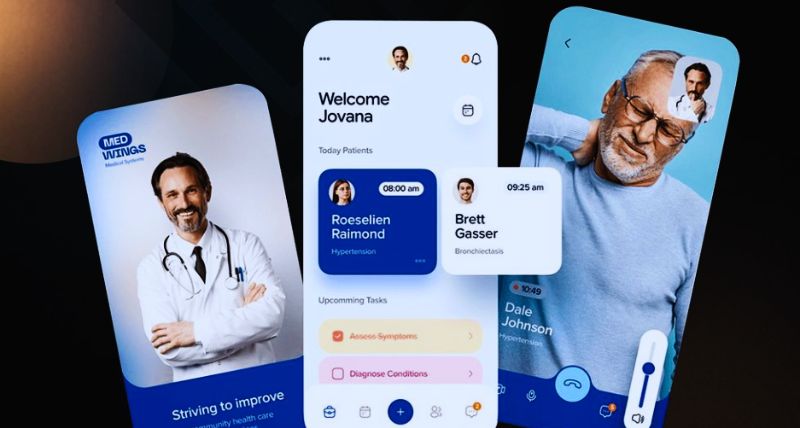The popularity of telemedicine has been steadily increasing ever since the Covid-19 pandemic. This article explores the complexities of telehealth, including market trends, benefits, a thorough how-to guide for shaping the future of telemedicine applications, and tactics for making them become powerful revenue-generating ventures.
Telemedicine Unveiled: A Shifting Paradigm
Telemedicine has become a disruptive force in the ever-changing healthcare industry by providing remote medical consultations via digital platforms. Its acceptance was expedited by the worldwide paradigm change brought about by the COVID-19 pandemic, which led to a greater dependence on virtual medical consultations due to safety concerns and lockdowns.
Telehealth services’ accessibility and ease of use have driven the sector ahead and established it as a competitive alternative to conventional in-person medical consultations. As of 2019, the telemedicine global market was valued at some 50 billion U.S. dollars. The market was forecast to grow significantly in the future when it was projected to be valued at nearly 460 billion U.S. dollars by 2030.
The telehealth scene has experienced tremendous changes with the introduction of cutting-edge technology, opening the door to a new era in patient care.
Trends Shaping Telehealth: Navigating the Digital Wave
The field of telehealth is always changing, and major themes are influencing its evolution. These patterns show how patient requirements are evolving as well as the creative solutions that technology is bringing to the healthcare industry.
|
Mobile Health Applications |
Due to the widespread use of smartphones, patients may now easily communicate with healthcare providers thanks to the availability of mobile health applications. Through an intuitive interface, mobile applications serve as a bridge, enabling users to book appointments, view medical information, and even get prescriptions. |
|
Remote Monitoring Devices |
Wearable technology has made its way into the healthcare industry, enabling real-time vital sign monitoring and giving medical professionals useful data. By sharing real-time health data with their doctors, patients with wearables such as smartwatches can promote proactive healthcare management. |
|
Integration of AI and Machine Learning |
By helping medical practitioners make educated decisions, intelligent algorithms are transforming diagnosis and treatment. Artificial intelligence (AI)-driven solutions are shaping telemedicine’s overall effectiveness. It can provide individualized treatment options and identify potential health problems, all without a single finger lifted by a human. |
|
Telepsychiatry and Mental Health Services |
The need for mental health services has significantly increased in the telehealth industry. For people struggling with mental health issues, telepsychiatry offers remote therapy and support. Truly a lifeline for those who cannot get to an appointment. |
Advantages and Disadvantages: Navigating the Telehealth Terrain
It is crucial to think through the complex benefits and drawbacks of telemedicine before embracing this cutting-edge method of providing healthcare.
Advantages
|
Accessibility |
Convenience |
Cost-Effectiveness |
|
Shaping telemedicine landscape, makes healthcare accessible to underprivileged and rural places by overcoming geographical constraints. Expert consultations are accessible to patients in remote or rural areas without requiring them to make long trips. |
Patients don’t have to go and wait longer because they may receive consultations from the convenience of their homes. This convenience is especially important for people who have chronic illnesses or limited mobility. |
Compared to conventional in-person appointments, virtual consultations frequently show to be more economical. Both patients and healthcare professionals benefit from lower travel costs and more effective use of resources. |
Disadvantages:
|
Technology Barriers |
Limited Physical Examination |
Security Concerns |
|
Widespread use of technology is hampered by unequal access to it and erratic internet connections. While metropolitan locations could have smooth connectivity, telehealth services might be difficult to get in rural or economically disadvantaged places. |
It might be difficult to conduct remote consultations for some medical issues that require a hands-on approach. Even while technological improvements are closing this gap, some situations still require a physical evaluation. |
There are legitimate worries about data security and privacy while transmitting sensitive medical information. To protect patient privacy, telehealth systems need to give strong authentication and encryption a priority. |
Monetization Strategies: Transforming Health Into Wealth
Now let’s talk about money. There are a few different ways to make money off of a telemedicine application. The long-term viability of any telehealth platform depends on striking a balance between the delivery of high-quality medical services and viable income streams.
1. Subscription Models: Create tiers of subscription plans with different service levels; start with basic consultations and work your way up to premium plans with more features and exclusive access. This strategy guarantees a consistent flow of income for shaping telemedicine platforms, while simultaneously meeting the diverse demands of patients.
2. In-App Purchases: Include elements that can only be unlocked through in-app purchases, such more healthcare resources, instructional materials, or access to special online health events. This approach gives the telehealth operator an extra source of income while enabling consumers to personalize their experience.
3. Partnerships and Collaborations: Form alliances with pharmaceutical firms or healthcare facilities to open the door to revenue-sharing and cooperative ventures that benefit both parties. This might entail collaborative research projects, co-branded campaigns, or special services.
4. Data Analytics Services: Take advantage of the abundance of data produced by the application by charging academic institutions or pharmaceutical businesses for anonymized, aggregated data. This not only helps progress medical research but also gives the telehealth platform an additional source of income.
Developing Your Telemedicine Application: A Step-by-Step Guide
Those who are starting the process of shaping telemedicine application should take a methodical approach. A strong and user-focused telehealth platform must take into account a number of important aspects, from clearly stating its goals to guaranteeing adherence to healthcare laws.
-
Clearly state your application’s main goals: Whether they are related to general health consultations, mental health services, or specialist medical sectors. Comprehending the demands of your intended audience is essential for the success of any telehealth platform.
-
User-Friendly Interface: To ensure efficient navigation and a satisfying user experience, give top priority to the design of an intuitive and user-friendly interface. The platform should be simple to use for both patients and medical professionals, with features that facilitate rather than complicate the consultation process.
-
Regulation Compliance: Become knowledgeable about healthcare rules and make sure your application complies with industry norms and data protection legislation. In the healthcare industry, following the law is a must for maintaining the faith and trust of patients and healthcare practitioners.
-
Integration of Security Measures: To protect sensitive patient data, put strong security measures in place. These include secure authentication procedures and encryption. Ensuring patient privacy is crucial, and establishing and preserving confidence requires a secure telehealth platform.
-
Seamless Payment Integration: Provide a smooth payment integration procedure so that consumers may easily subscribe or make in-app purchases if monetization is the aim. Users are more likely to explore premium services and have a better overall experience when the payment procedure is simple and safe.
Understanding the Cost of Development: Balancing Quality and Budget
Finding a balance between budgetary constraints and quality is essential when it comes to development. There are several aspects involved in shaping telemedicine application, all of which contribute to the platform’s overall success.
|
Development Team |
Set aside funds for a knowledgeable group of developers, UI/UX designers, and medical experts who will be essential to the success of your idea. The effectiveness and caliber of your telehealth platform are strongly impacted by the experience of your staff. |
|
Technology Stack |
Based on the needs of your project, choose between native and hybrid development methodologies when making well-informed selections about the technology stack. Your telemedicine application’s speed, scalability, and general user experience are all impacted by the technological stack. |
|
Compliance and Security |
Provide adequate funding to guarantee adherence to healthcare laws and to put strong security measures in place to protect private patient data. Putting money into security and compliance procedures is a proactive way to reduce risks and make sure your telehealth platform is successful in the long run. |
|
Testing and Quality Assurance |
To guarantee the dependability and security of how you will finish shaping telemedicine applications, commit resources to thorough testing and quality assurance processes. Extensive testing helps to improve customer satisfaction with the platform by helping to find and fix possible problems. |
|
Scalability and further updates |
Take into account the telehealth platform’s scalability and make plans for further updates. The platform should be able to manage more data and traffic as the user base expands without experiencing any performance issues. Your telemedicine application will stay competitive and relevant in the changing healthcare environment if you make regular upgrades and enhancements. |
In Conclusion: Shaping Telemedicine Horizon
It’s clear that the digital revolution of healthcare is a long-lasting trend as we make our way through the complicated world of telemedicine. The possibilities and difficulties are shown on a dynamic canvas by the trends, benefits, and problems. A careful approach is required while shaping telemedicine application, combining the needs of the user with the complexities of the healthcare sector.
Shaping telemedicine frontier appeals to anybody with an interest in digital health, be it an entrepreneur with a vision for the future or a healthcare practitioner seeking to expand their practice. Take advantage of the opportunities, innovate sensibly, and steer the ship toward a more accessible and healthy future. The revolution in telehealth is beckoning — are you prepared to answer? Telemedicine is a shining example of advancement in the healthcare industry, providing a revolutionary method of patient care in the digital era.







 December 31, 2023
December 31, 2023






